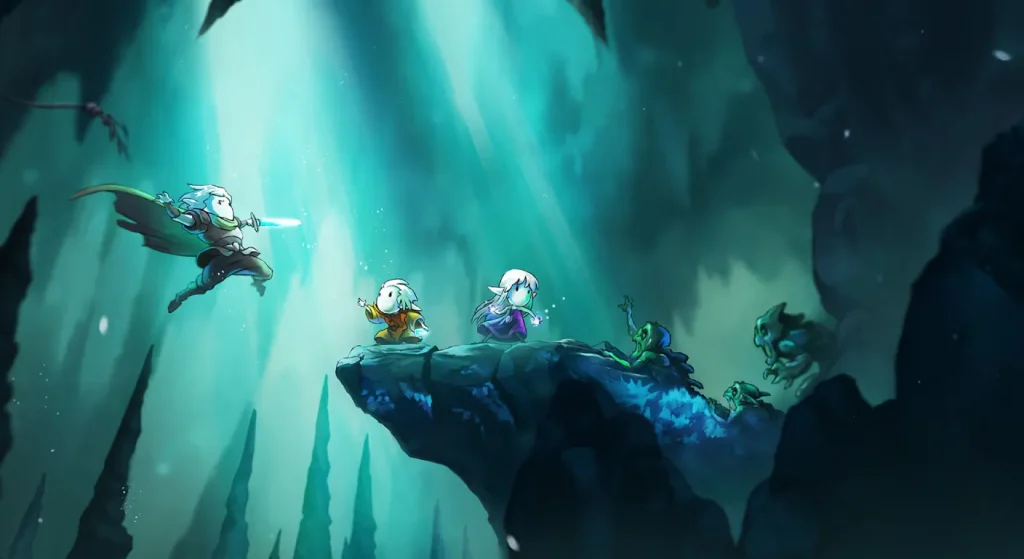what is video game development?
Video game development is the process of designing, creating, and programming games, combining art, story, sound, and technology to produce interactive entertainment.

Key Highlights
- Game development is a multi-stage process, starting with planning and pre-production and moving through production, testing, and post-launch support.
- Successful video game development relies on a clear game design document and a skilled, collaborative team.
- Choosing the right game engine, like Unity or Unreal Engine, is a critical decision for any game dev project.
- The game development pipeline isn’t always linear; modern studios often use agile methods to adapt to changes.
- Essential skills for aspiring developers include both technical abilities like programming and crucial soft skills like communication.
Introduction
Have you ever wondered how your favorite video games are made? The video game industry is a massive, exciting field, and breaking into it might seem daunting. This guide is here to demystify the video game development process for you. Whether you’re a complete beginner game developer or just curious about the magic behind the screen, we’ll walk you through the foundational steps, essential roles, and key tools you need to know to start your journey in game creation.
Understanding the Foundations of Game Development
What is the difference between 2D and 3D game development?
2D game development involves creating a game on a flat plane with height and width, using sprites and 2D assets. 3D game development adds depth, creating a game world with three dimensions. 3D game design is generally more complex, requiring 3D models and more intensive calculations for graphics.
Before you can create your own game, it’s important to grasp the fundamentals. The video game development process is a blend of creative vision and technical execution. It begins not with code, but with an idea, which game designers then shape into a playable concept.
For anyone wondering how to start with no experience, the first step is learning these core principles. Understanding what makes a game fun, engaging, and functional is the bedrock of all game dev. Let’s explore the evolution of gaming and the core values that guide modern design.
The Evolution of Modern Gaming
Video games have come a long way from their simple origins. What started as basic pixelated entertainment has transformed into a sophisticated form of interactive entertainment, featuring complex narratives and vast, immersive game worlds. This evolution was driven by technological advancements and a growing ambition to create more engaging experiences.
Modern video game development now involves large teams of specialists, from programmers to artists, who collaborate to bring these digital worlds to life. The process is far more intricate, involving detailed planning, prototyping, and extensive testing to meet player expectations for high-quality graphics and seamless gameplay.
For beginners, understanding this journey is inspiring. It shows that even the most complex video game starts with a basic concept. The key steps always involve refining that idea, building a prototype, developing the assets, and polishing the final product for players to enjoy.
Gaming in Numbers: Key Industry Data and Trends
The video game industry is not just a creative field; it’s a global economic powerhouse. The market was projected to surpass $200 billion by 2023, showcasing its incredible growth. In the United States alone, video game sales can reach billions in a single month, especially during holiday seasons, highlighting the massive consumer demand.
A significant portion of this growth comes from the mobile game market. Mobile devices have become a primary distribution channel, making games more accessible than ever. This shift has opened up new opportunities for developers to reach a broad audience. According to Newzoo’s Global Games Market Report, mobile gaming continues to command the largest share of the market revenue. [1]
Here’s a quick look at some key industry figures:
| Metric | Data Point |
|---|---|
| Global Market Size (2023 est.) | Over $200 Billion |
| Peak Monthly US Sales (Dec 2023) | Over $7.91 Billion |
| Mobile Gaming Market Share | Largest segment of the industry |
Core Values in Game Design: Collaboration, Resilience, Competition
Great game design is about more than just fun mechanics; it’s about the values embedded within the gameplay. These underlying principles shape the player’s experience and can even influence their behavior. Smart game dev teams intentionally design around these values.
On larger projects, a cohesive vision is critical. The development team must decide early on what feelings or behaviors they want to encourage. Are you building a game that fosters teamwork, or one that rewards solo perseverance? This decision influences every aspect of the game design, from level structure to reward systems.
Some core values baked into game design include:
- Collaboration: Encouraging players to work together to solve puzzles or defeat enemies.
- Resilience: Creating challenges that push players to learn from failure and try again.
- Competition: Designing systems that allow players of any skill level to compete in a fair and engaging way.
What Makes Up a Game? Key Elements and Principles of game design and development

At its core, every game is a collection of carefully crafted elements working together to create an interactive experience. Your game concept is brought to life through gameplay mechanics, which are the rules and actions that players can perform. These mechanics are supported by visual art, game characters, and a clear user interface.
Sound design also plays a crucial role, adding emotional depth and providing important feedback to the player. Understanding how these pieces fit together is the first step toward deconstructing and, eventually, building your own games. Let’s look at these elements in more detail.
Mechanics, Dynamics, and Aesthetics Explained
The framework of any game can be broken down into three key components: Mechanics, Dynamics, and Aesthetics (MDA). This model helps designers understand how players experience their game.
Mechanics are the foundational rules and systems of the game. This includes everything from how a character jumps to the logic behind the scoring system, all of which is implemented through game programming. They are the “verbs” of the game—what the player can do.
Dynamics are the emergent behaviors that arise when players interact with the game’s mechanics. For example, a simple mechanic of “jumping” can lead to dynamics like “sequence breaking” or “speed-running.” Finally, aesthetics are the emotional responses evoked in the player. This is achieved through visual effects, sound effects, and the overall feel of the game world, creating feelings of challenge, discovery, or fantasy.
Values-Driven Design: Embedding Meaning in Gameplay
Beyond just rules and graphics, modern game design and development often incorporates a values-driven approach. This means intentionally embedding a deeper meaning or message into the core gameplay loop. It’s about thinking what you want your players to feel and take away from the experience, which can differentiate your own game in a crowded market.
This philosophy shapes the entire user experience. A game designed around “creativity” might offer robust building tools, while one focused on “empathy” might present players with difficult moral choices. These values should be clearly outlined in the design document to guide the game dev team throughout the project.
Key principles of values-driven design include:
- Intentionality: Every mechanic should serve the game’s core values.
- Player-Centricity: The design should focus on the emotional journey of the player.
- Cohesion: The story, gameplay, and art must all work together to reinforce the intended message.
Examples of Popular Game Genres and Their Unique Features
The world of video games is incredibly diverse, with countless genres each offering a unique type of game experience. Understanding these genres is key to refining your game design ideas. Whether you are an indie game developer or part of a large studio, choosing a genre defines your audience and gameplay loop.
For example, Role-Playing Games (RPGs) focus on character progression and story, while Strategy games challenge players’ tactical thinking. The rise of the mobile game market has also popularized genres like puzzle games and hyper-casual titles, which are designed for short, engaging play sessions. Each genre has its own set of player expectations.
Here are a few popular genres and their features:
- Action/Adventure: Combines exploration with combat and puzzle-solving.
- Platformer: Focuses on jumping and navigating challenging environments.
- Shooter (First/Third-Person): Emphasizes combat with ranged weapons.
- Simulation: Aims to replicate real-world activities, from farming to city management.
The Game Development Pipeline: From Idea to Launch

The game design and development process is often visualized as a pipeline, a series of stages that take a game from a simple idea to a finished product. This structured workflow helps game development studios manage complex projects, ensuring that everyone from designers to game testers is aligned and on schedule.
While the pipeline provides a roadmap, it’s rarely a straight line. Each stage presents unique challenges and opportunities for refinement. Understanding these stages of game development is essential for anyone looking to navigate the creation process successfully. Let’s break down what happens at each step.
Stages of Game Creation: Concept to Completion
Every game begins with a single game idea. This initial concept is then developed during the pre-production phase, where the core mechanics, story, and art style are defined in a game design document (GDD). This document serves as the blueprint for the entire project.
Once the plan is solid, the project moves into production, the longest and most intensive phase of the game development process. Here, programmers write the code, artists create the assets, and designers build the levels. This is followed by rigorous testing phases, including alpha testing (internal checks) and beta testing (player feedback), to find and fix bugs.
The main stages are:
- Pre-Production: Planning, concept development, and creating the GDD.
- Production: Building the game, including coding, art, and sound.
- Testing: Quality assurance, bug fixing, alpha testing, and beta testing.
- Post-Production: Launch, marketing, and ongoing support with patches and updates.
Reality Check: Insights from Developers on Agile Workflows
While the traditional pipeline seems linear, any experienced video game developer will tell you that development is often chaotic and unpredictable. A feature that sounds great on paper might not be fun in practice, forcing the development team to pivot. This is where an agile workflow becomes invaluable for project management.
Instead of sticking rigidly to a pre-defined plan, agile methodologies like Scrum and Kanban allow teams to work in short, iterative cycles. This approach helps game programmers and artists adapt to constant changes, get feedback faster, and refine the game as they go. It prioritizes building a working product over extensive documentation.
An agile workflow embraces:
- Flexibility: The ability to change direction based on testing and feedback.
- Iteration: Building and refining features in small, manageable chunks.
- Collaboration: Constant communication between all members of the development team.
Navigating Challenges and Chaos in Real Studio Environments
What are some common challenges for beginners in game development?
For a beginner game developer, common challenges include choosing a project that is too ambitious, getting stuck on technical problems, and losing motivation. The key to overcoming these is to start with a very simple own game, focus on finishing it, and not be afraid to ask for help.
Game development studios are exciting, creative places, but they are also filled with real-world challenges. The video game development process is rarely smooth, and teams must be prepared to navigate unexpected hurdles, especially when you’re trying to create your own game.
One of the biggest challenges is “feature creep,” where new ideas are continuously added, pushing deadlines and straining budgets. Another common issue is technical debt, where quick coding fixes lead to bigger problems down the line. Overcoming these obstacles requires strong project management and a resilient team that can adapt to the often-chaotic nature of creation.
Common real-world challenges include:
- Budget and Time Constraints: Balancing creative vision with financial realities.
- Technical Hurdles: Encountering unexpected bugs or performance issues.
- Team Dynamics: Ensuring effective communication and collaboration under pressure.
Beginner’s Guide: How to Get Started in Game Development
How long does it take to create a simple video game?
The time it takes to make your first game can vary widely. A very simple game dev project, like a basic arcade-style game, could be completed in a weekend during a game jam. A slightly more complex own game might take a few months of part-time work.
Ready to start making your own game? For a beginner game developer, the journey begins with gathering the right tools and knowledge. You don’t need a massive studio; the modern development process is more accessible than ever, thanks to powerful and often free game development tools.
The key is to start small, focus on learning the fundamentals, and connect with others who share your passion. This section will guide you through the essential equipment you’ll need, popular video game design programs (such as Unity, Unreal Engine, Godot, and Blender), where to find learning resources, and how to build a support network to help you succeed.
Essential Equipment, Software, and Resources for Starters
To start making your own game, you don’t need a Hollywood-sized budget. A reliable computer is the most crucial piece of equipment. From there, your most important tool will be a game engine, which is the software framework for building and running your game.
Many game development tools are free for beginners. Engines like Unity and Unreal Engine offer powerful features for both 2D and 3D development. You can also find free software for art creation, like Blender for 3D modeling, and for sound design, like Audacity. For project management, tools like Jira or Trello can help you stay organized, while Git is essential for version control.
Here are the essentials to get you started:
- A solid computer: Capable of running a modern game engine.
- A game engine: Unity (uses C#) or Unreal Engine (uses C++ and Blueprints).
- Asset creation tools: Software for art, animation, and sound design.
Finding Beginner-Friendly Courses and Online Communities
As a beginner game developer, you don’t have to learn everything on your own. There is a wealth of resources available online to guide you through the game development process. Many platforms offer courses specifically designed for those who are just starting to make their own game.
Beyond formal courses, online communities are an invaluable resource. Forums like Reddit’s r/gamedev, Discord servers, and groups on social media are filled with developers willing to share knowledge, offer feedback, and provide encouragement. Joining these communities is a great way to stay motivated and learn from the experiences of others.
Look for a beginner-friendly course or community on:
- Learning Platforms: Udemy, Coursera, and the official learning portals for Unity and Unreal Engine.
- YouTube: Countless tutorials from experienced developers.
- Forums and Social Media: Reddit, Discord, and Twitter communities dedicated to game development.
- Game Jams: Events like Ludum Dare where you can practice and meet other developers.
Building Your Foundation: Learning Platforms and Support Networks
Starting your game dev journey requires building a strong foundation of knowledge and having reliable support networks. Learning platforms provide structured paths to acquire technical skills, but they are just one piece of the puzzle. How do you start with no prior experience? Pick one engine and one simple project, and see it through to completion.
Active participation in support networks is just as important. These communities offer a space to ask questions, share your progress on your own game, and get feedback from peers and mentors. This collaborative environment can help you overcome challenges and stay motivated when you hit a roadblock.
To build your foundation, focus on:
- Structured Learning: Choose learning platforms that offer clear, project-based tutorials.
- Community Engagement: Join forums and Discord servers to connect with other developers.
- Finding a Mentor: Seek out experienced game dev professionals who can offer guidance and support.
Step-by-Step Process for Developing Your First Game
Creating your first game is an exciting milestone for any game dev enthusiast. The first step is to break down the massive game development process into smaller, manageable tasks. Don’t aim to build a sprawling open-world epic on your first try. Instead, focus on a simple, achievable project to learn the ropes.
From crafting the initial game design document to launching the final product, each step teaches you something valuable. This section provides a clear, step-by-step guide to help you navigate the journey of building your first game.
Step 1: Planning and Pre-production Essentials
The first stage of the development process is all about planning. Before you write a single line of code, you need a clear game concept. What is your game about? Who is it for? What are the core mechanics? Answering these questions early will save you a lot of time later.
This information is compiled into a game design document (GDD), which acts as your project’s North Star. However, a GDD isn’t the only tool. Modern studios often use collaborative platforms like Miro or Figma to brainstorm ideas and map out user flows visually. The goal is to create a shared understanding of the vision, making project management much easier.
Your pre-production checklist should include:
- A core game concept: A simple, one-sentence description of your game.
- A Game Design Document (GDD): Outlining mechanics, story, and goals.
- Visual brainstorming: Using tools like Miro or Figma to complement the GDD.
Step 2: Prototyping and Early Testing
Once you have a plan, it’s time to build a prototype. A prototype is a basic, playable version of your game that tests the core mechanics. It doesn’t need to be pretty; its purpose is to answer one critical question: “Is this fun?” For simple games, this stage can be incredibly fast and insightful.
Prototyping helps you identify design flaws early, long before you’ve invested heavily in art or detailed level design. Tom Greever highlights the importance of this stage, stating, “Interactive prototypes go beyond visualization — they validate ideas, engage stakeholders, and accelerate development.” This early testing is far more valuable than any amount of on-paper design.
Key goals for prototyping are:
- Test core mechanics: Ensure the main gameplay loop is engaging.
- Find the fun: Discover what makes your game enjoyable.
- Fail fast: Identify and fix problems before they become costly to change.
Step 3: Production—Design, Programming, and Asset Creation
With a successful prototype, you move into the production phase. This is where your game truly comes to life. Game programmers write the code that powers the mechanics, while game artists create the characters, environments, and visual effects that define the game’s look and feel.
This stage is a collaborative effort. Sound designers create audio cues and music, while UI/UX designers build an intuitive user interface. Every element is created and integrated into the game engine, transforming your concept into a tangible, interactive world. It’s the longest and most resource-intensive part of development.
Production involves creating:
- Code: Game programming for all mechanics and systems.
- Art: 2D or 3D models, textures, and animations.
- Audio: Sound effects and background music.
- User Interface: Menus, HUDs, and other on-screen elements.
Step 4: Quality Assurance, Player Feedback, and Iteration
As production progresses, quality assurance (QA) becomes essential. Game testers are brought in to find and report bugs, but modern QA goes beyond simple bug hunting. Today, developers rely on data-driven methods to improve the user experience.
By analyzing player feedback and behavior, teams can identify design flaws. For example, heatmaps might show where players are getting stuck in a level, while funnel analysis can reveal where they drop off. This data allows for targeted iteration, ensuring the final game is not just bug-free but also genuinely enjoyable and well-balanced. This feedback loop helps refine the original game idea.
Data-driven QA includes:
- Analytics: Tracking player behavior to identify pain points.
- Heatmaps: Visualizing where players go and interact within the game world.
- A/B Testing: Comparing different design choices to see which performs better.
Step 5: Polishing, Pre-launch Activities, and Release
The final stage before release is all about polishing. This is where you add the small details that elevate a good game to a great one. This includes refining animations, balancing difficulty, and optimizing performance. During this phase, you also begin pre-launch activities to build excitement.
This is also the time to consider the psychological impact of your design. Elements like satisfying audio cues for rewards or clear visual patterns create an emotional connection with the player, making the experience more memorable. Once the final product is ready, you’ll prepare it for release on distribution platforms like the Apple App Store or Steam.
Key activities in this stage are:
- Polishing: Refining gameplay, visuals, and sound for a high-quality feel.
- Marketing: Creating trailers, and reaching out to influencers.
- Submission: Preparing the game for release on your chosen platforms.
Tools, Technologies, and Skills for Success
To succeed in game development, you need the right combination of tools and skills. Choosing the correct game engine and programming language for your project is a critical first decision. These technologies form the foundation upon which your entire game is built.
Equally important are the skills you bring to the table. Beyond technical game programming knowledge, the industry demands strong soft skills and an understanding of modern practices, including ethical AI use. Let’s explore the essential tools and skills that will set you up for success.
Choosing the Right Game Engine: Unity, Unreal, and More
Selecting a game engine is one of the most important decisions you’ll make. Your choice will impact your workflow, the platforms you can release on, and the type of game you can create. Unity and Unreal Engine are the two dominant forces in the industry, but each has its strengths.
Unity is renowned for its flexibility and strong support for mobile game development. Its C# programming language is often considered easier to learn for beginners. Unreal Engine, on the other hand, is famous for its cutting-edge graphics and its visual scripting system, Blueprints, which allows for development without extensive coding.
Here’s a quick comparison to help you choose:
| Factor | Unity | Unreal Engine |
|---|---|---|
| Best For | Indie games, mobile, 2D & 3D projects | AAA graphics, large-scale 3D projects |
| Primary Language | C# | C++ and Blueprints (visual scripting) |
| Learning Curve | Generally considered easier for beginners | Steeper, but Blueprints helps |
| Cost | Free for personal use, revenue-based plans | Free to use, takes a royalty after a certain revenue threshold |
Programming Languages in Game Development: Pros and Cons
While some game engines offer visual scripting, a strong grasp of a programming language is a powerful skill for any developer. The language you use often depends on the game engine you’ve chosen. A background in computer science is helpful but not always necessary, as many resources are available for all skill levels.
C++ is the industry standard for high-performance game programming, used by Unreal Engine and most AAA studios. It offers maximum control over hardware but has a steep learning curve. C# is the language of Unity and is known for being more user-friendly and faster to develop with, making it a popular choice for indie and mobile games.
Key languages in game development:
- C++: Pro: Maximum performance and control. Con: Complex and difficult to learn.
- C#: Pro: Easier to learn, rapid development. Con: Less direct control over hardware compared to C++.
- Python: Pro: Simple syntax, great for scripting. Con: Not typically used for building entire game engines due to slower performance.
Essential Technical and Soft Skills for Aspiring Developers
To build your own game, you’ll need a solid set of technical skills. This includes proficiency in a programming language, familiarity with a game engine, and an understanding of 3D modeling or 2D art principles. These hard skills are the foundation of any game dev role.
However, soft skills are just as critical, especially when working in a development team. Game development is a collaborative process, often under high pressure. The ability to communicate clearly, adapt to unexpected changes, and work well with others can be the difference between a successful project and a failed one. These skills are essential for surviving and thriving in the industry.
Essential skills for a successful developer include:
- Technical Skills: Programming, engine expertise, and art/design principles.
- Communication: Clearly explaining ideas and providing constructive feedback.
- Adaptability: Being able to pivot when a design isn’t working or priorities change.
Advanced Optimization and Ethical AI Use in Modern Games
As video game development becomes more complex, advanced skills in optimization and AI use are increasingly valuable. Performance optimization is crucial for ensuring a game runs smoothly on all target hardware. Techniques like memory pooling, Level of Detail (LOD) systems, and asynchronous asset loading are used to maximize performance without sacrificing visual quality.
The use of AI in games is also growing rapidly, from powering intelligent NPCs to procedurally generating vast game worlds. However, this raises questions about ethical AI use. Developers must consider the implications of creating adaptive difficulty that could be manipulative or using AI to generate content without human oversight. Understanding these advanced game development tools and their ethical dimensions is key for the modern developer.
Key areas of advanced development include:
- Performance Optimization: Using techniques like LODs to ensure smooth frame rates.
- AI in Design: Leveraging AI for procedural generation and creating intelligent NPCs.
- Ethical AI: Considering the moral and social impact of AI-driven game mechanics.
Conclusion
In conclusion, starting your journey in game development can be both exciting and overwhelming. By understanding the foundational concepts, such as core values, essential tools, and the game development pipeline, you can effectively navigate this vibrant industry. Embrace the learning opportunities available through courses and supportive communities, and don’t hesitate to seek out resources that can guide you through each stage of your first game creation. Remember, persistence is key, and with every challenge you face, you’ll grow as a developer. If you’re ready to dive deeper into your game development journey, get a free consultation to help you map your path forward!
Where can I find supportive online communities for new game developers?
Supportive online communities are everywhere! A beginner game developer can find great support networks on platforms like Reddit (r/gamedev), Discord servers dedicated to specific game engines, and on social media using hashtags like #gamedev. These are excellent places to share your own game and get feedback.
 View on Google Maps
View on Google Maps






